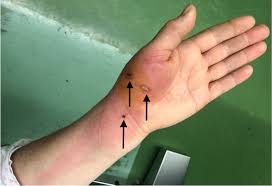 5-15% of all animal bites with an infection rate as high as 50%.
5-15% of all animal bites with an infection rate as high as 50%.
Cat bites are bites inflicted upon humans, other cats, and other animals by the domestic cat.
Occur more common in women and an older population compared to dog bites.
Over 400,000 cat bites are reported each year in the US, though the actual number of bites is much higher since many such bites are under-reported.
40 million households in the United States have domestic cats.
Nearly half of individuals are older than 20 years and up to two thirds of lesions occur on the upper extremity, typically the hand.
85% of bites are puncture wounds and up to two thirds occur on the upper extremities.
Puncture wounds more likely to create infections than dog bites so that 30-50% of such injuries become infected.
Small but sharp tooth structure can puncture deep into skin, soft tissues, bone and joints enabling deposits of infectious material.
Cat bites can sometimes lead to complications and, very rarely, death.
They are usually considered minor injuries but can result in serious infection.
Common symptoms include pain and swelling around the affected area, and direct tissue damage from the cat bite can impair mobility or cause tenosynovitis or arthritis.
Rarely, deep-vein thrombosis, subcutaneous emphysema and fetal tachycardia have been described.
Domestic cat mouth flora includes: Pasteurella, Staph, Bartonella, and Streptococcus species.
Bites from cats develop infections more frequently than bites from dogs.
Cat’s teeth are sharp, and can cause deep wounds.
The skin usually closes rapidly over a cat bite and may trap microorganisms.
Cat bite infections include:
Cat-scratch disease, caused by the bacterium Bartonella henselae.
Hookworm, Ancylostoma tubaeforme, Ancylostoma braziliense, and Uncinaria stenocephala
Capnocytophaga canimorsus
Pasteurellosis caused by the bacterial genus Pasteurella
Pasteurellosis is a bacterial disease associated with animal bites and scratches.
Pasteurella spp is a normal bacterium that also lives in the mouths of healthy cats.
The bacteria do not typically make cats sick.
But cats can develop abscesses or skin infections in places where they were scratched or bitten by another animal.
In people, pasteurellosis causes painful wound and skin infections, and in severe cases, can cause widespread infection and might even affect the nervous system.
Rabies is caused by a virus-Infected cats may have a variety of signs, but most often have sudden behavioral changes and progressive paralysis.
The diagnosis is aided by obtaining a history of the circumstances surrounding the bite: time the bite was experienced, the location of the bite, and examination of the bite is noted.
It may be necessary to open and explore a draining wound.
The diagnosis of a cat with rabies is usually evident by observing the cat: restlessness, panting , and attacking other animals, people, or objects.
Vaccination of the cat can prevent rabies being transmitted by the cat through a bite.
If the cat is suspected of being infected with rabies, the person bitten will immediately begin treatment with rabies vaccine.
Cat bites can often be prevented.
Treatment
The first step is washing and then irrigating the bite wound with water and isopropyl alcohol.
Often, a tetanus shot is prescribed.
If the wound has a low risk of being infected, it is sometimes only sutured.
If a cat has bitten someone, and there is no evidence that the cat has been vaccinated against rabies, the person should be treated for rabies infection.
20–80% of cat bites and scratches become infected.
Cat-scratch disease that causes fever and swollen lymph nodes, can develop from cat scratches even if they only break the surface of the skin.
Women are most likely to be victims of cat bites and scratches.
Children are more likely to be bitten on their head, neck and face.
Adults are more likely to bitten on the hands and arms.
Immunocompromised individuals are more susceptible to infection from a cat bite.
Cat bites are more common found in older adults, particularly those over 75 years old.
Cat bites are more frequent in the mornings, during spring and summer.
The most commonly affected human body part are the arms.
At attackers are usually stray females.
